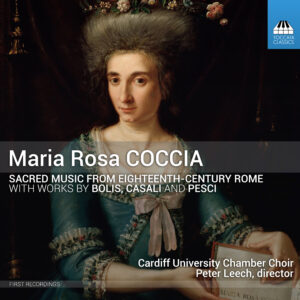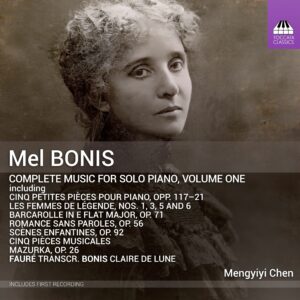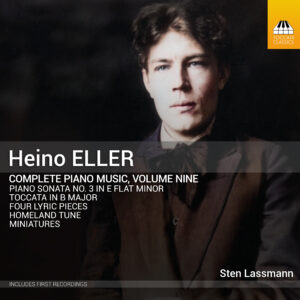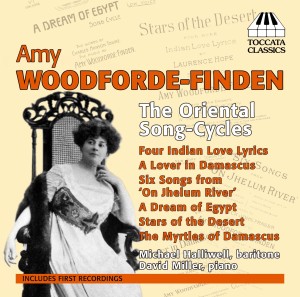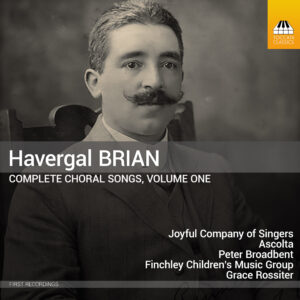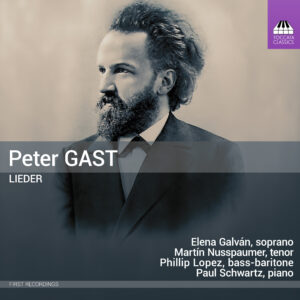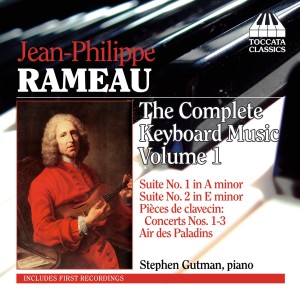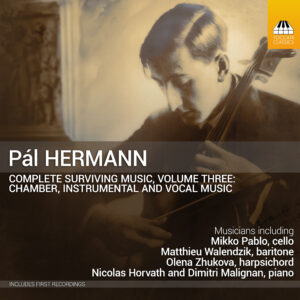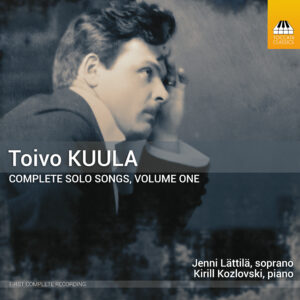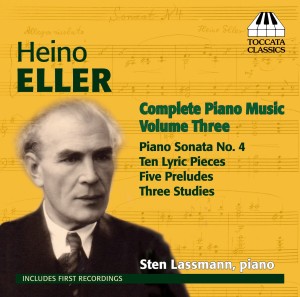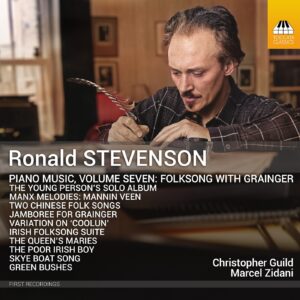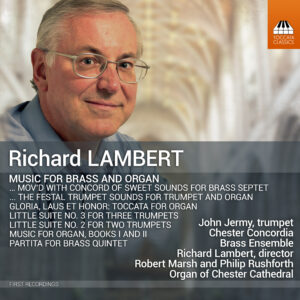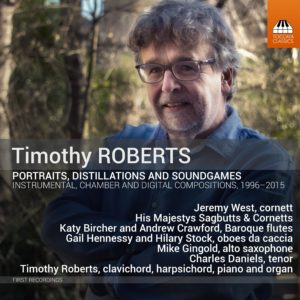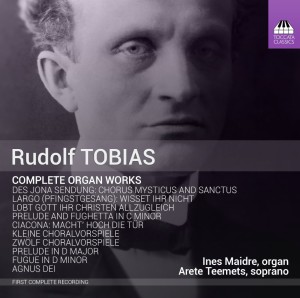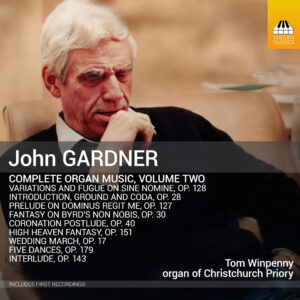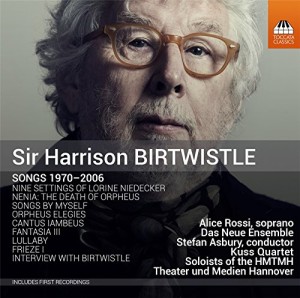Search Results for "Space Wolf: The First Omnibus mp3 torrent" – Page 6
Maria Rosa Coccia: Sacred Music from 18th Century Rome
The Roman Maria Rosa Coccia (1759–1833) was a musical phenomenon of almost Mozartian precocity, becoming the first female composer to be awarded the professional distinction of maestra di cappella – at the age of fifteen. But the church could not contemplate the idea of a woman in charge of the music-making in a religious establishment, and so she hit a stained-glass ceiling; she seems to have given up composition in the mid-1780s, not yet 30. The freshness and buoyancy of her writing up to that point give an indication of what might have been.
Cardiff University Chamber Choir
Peter Leech, director
Robert Court, chamber organ
Mel Bonis: Complete Music for Solo Piano, Volume One
Mélanie Bonis (1858–1937), a fine pianist herself, composed some 150 works for solo piano, publishing them with her first name shortened to ‘Mel’ to disguise the fact that she was a woman – while she lived among the French haute bourgeoisie as Mme Domange. They sometimes show the influence of Chabrier, and have points of contact with the music of Chausson, Debussy and Pierné, who had been fellow students at the Paris Conservatoire. But they also reveal an individual approach to rhythm, harmony and tone-colour – and it’s clear that her conventional exterior hid a lively sense of fun, her many miniatures for children perhaps influenced by her own experience as a mother.
Mengyiyi Chen, piano
Heino Eller: Complete Piano Music, Volume Nine
The piano music of Heino Eller (1887–1970), a total of 206 works, is not only the largest part of his output: it is also the largest body of works in Estonian classical music. But most of these pieces are unknown, even though the best of them are original contributions to the twentieth-century piano repertoire, with Eller’s sensitive lyricism underpinned by gentle humour and an occasional epic tone. This ninth and final volume in its first-ever complete recording prefaces his expansive Piano Sonata No. 3 with a series of charming miniatures and ends with the emblematic anthem Homeland Tune, a musical embodiment of Estonian national feeling.
Sten Lassmann, piano
Amy Woodforde-Finden: The Oriental Song-Cycles
Amy Woodforde-Finden (1860-1919) wrote a number of 'oriental' song-cycles, one of which, the Four Indian Love Lyrics of 1902, contained the 'Kashmiri Song' — beginning 'Pale hands I loved beside the Shalimar' — that became a runaway success in its own day. These ballads have long since fallen from favour, but they contain plenty of honest sentiment, good tunes and splashes of local colour — and their hints of inter-racial love and lesbian romance must have given a real frisson to their contemporary audiences.
Michael Halliwell, baritone
David Miller, piano
Havergal Brian: Complete Choral Songs, Volume One
The reputation of Havergal Brian (1876–1972) as a late-blossoming symphonist obscures the fact that he was an early-blossoming composer of choral music for the huge market of amateur choirs thriving in Edwardian England. His choral songs range from simple unison settings for children’s or women’s voices to harmonically complex essays intended to tax the ability of groups taking part in the choral competitions once popular in many parts of Britain.
Joyful Company of Singers
Peter Broadbent, conductor
Finchley Children’s Music Group
Grace Rossiter, conductor
Peter Gast: Lieder
The composer Peter Gast (1854–1918) – real name Heinrich Köselitz – is best remembered as a friend and posthumous editor of Friedrich Nietzsche rather than for his own music, which was kept under lock and key in communist East Germany for half a century; only recently has it begun to be performed and recorded. ‘Il faut méditerraniser la musique’, Nietzsche argued, and Gast’s Lieder, in a reaction against Wagnerian gloom, do just that, singing of love, life, springtime, drinking and youthful ardour; even the more wistful songs have a spring in their step.
Elena Galván, soprano
Martín Nusspaumer, tenor
Phillip Lopez, bass-baritone
Paul Schwartz, piano
Jean-Philippe Rameau: The Complete Keyboard Music, Volume One
Rameau was one of the great composers for the keyboard. But because pianists have not adopted his harpsichord music as they have that of the other great names of the Baroque – Bach, Handel and Scarlatti – his stature as a keyboard composer is not fully acknowledged. This series of three CDs presents all his keyboard music on the piano: the familiar suites, a number of discoveries and arrangements by his contemporaries.
Stephen Gutman, piano
Pál Hermann: Complete Surviving Music, Volume Three – Chamber Instrumental and Vocal Music
Pál Hermann, born in Budapest in 1902, was not only one of the leading cellists of his generation; he was also an important composer, one of the major figures in Hungarian music in the generation after his teachers Bartók and Kodály. But since only two of his works were published before his early death – in 1944, at the hands of the Nazis – and many more of them were lost, he has not had the esteem that he deserves. The kaleidoscopic variety of the works on this third, and final, volume of his surviving compositions – biting Bartókian piano pieces, Neo-Baroque essays of considerable contrapuntal ingenuity, songs with a French Impressionist flavour, even a sly transcription of a foxtrot – underlines how much was lost with his murder.
Nicolas Horvath, piano
Dimitri Malignan, piano
Elizaveta Agrafenina, soprano
Sára Gutvill, mezzo-soprano
Irina Bedicova, mezzo-soprano
Paul van Gastel, tenor
Pierre Mak, baritone
Matthieu Walendzik, baritone
Reine-Marie Verhagen, soprano recorder
Inês d’Avena, alto recorder
Dante Jongerius, tenor recorder
Punto Bawono, Baroque lute
Olena Zhukova, harpsichord
Olena Matselyukh, organ
Jean-Pierre Dassonville, horn
Sadie Fields, violin
Mikko Pablo, cello
Toivo Kuula: Complete Solo Songs, Volume One
Toivo Kuula (1883–1918) is one of the many composers who died at a tragically young age – 35 in his case, the result of an alcohol-fuelled pub brawl. The striking quality of the music he wrote during his short life points to the immensity of the loss not only to Finnish culture but to music more generally – as this first album of two, presenting his entire output of songs for solo voice and piano, makes abundantly clear. The range of moods captured here is striking, from cheery folksongs to dark existentialist contemplations of the meaning of life and death. The most passionate of them generate an operatic intensity in their short span, in a style that balances directness of expression and rich late-Romantic harmonies.
Jenni Lättilä, soprano
Kirill Kozlovski, piano
Heino Eller: Complete Piano Music, Volume Three
As both composer and teacher Heino Eller (1887-1970) was one of the founders of the classical tradition in his native Estonia. Yet his copious output for piano — some 200 works — is largely unknown, an omission this series of seven CDs seeks to redress. The central works of Volume Three are the Ten Lyric Pieces, mirroring the tragic loss of Eller's Jewish wife, murdered during the Nazi occupation, and Fourth Sonata, a late masterpiece that sums up a life's work. The three Studies here offer a glimpse of Eller's early virtuosic pursuits, and the five Preludes showcase his endeavours in an expressionist idiom.
Sten Lassmann, piano
Ronald Stevenson: Piano Music, Volume Seven – Folksongs with Grainger
Percy Grainger (1882–1961) and Ronald Stevenson (1928–2015), both composer-pianists of the Golden Age of keyboard virtuosity, shared a passion for folksong, especially the modal Celtic melodies from the fringes of the British Isles. Though the two never met, they corresponded for many years, with Stevenson arranging many of Grainger’s transcriptions in a deliberate act of homage to the older man, whose quirky originality brought Stevenson illumination on his own idiosyncratic path. This seventh instalment in Christopher Guild’s Toccata Classics survey of Stevenson’s piano music uncorks the exultant good humour that he and Grainger found on that common Celtic ground.
Christopher Guild, piano
Marcel Zidani, piano
Richard Lambert: Music for Brass and Organ
Richard Lambert, born in Bath in the English West Country in 1951, grew up with the sounds of organ and brass among his earliest musical experiences: he played cornet and trumpet as a boy and was soon taking organ lessons in Bath Abbey. His own compositions for brass and organ – many of them written to mark special occasions in the lives of friends and acquaintances – range in mood from the tender and intimate to the bold and heraldic, in a language downstream from Walton and Poulenc.
Chester Concordia Brass Ensemble
Richard Lambert, director
Philip Rushforth and Robert Marsh, organ of the Chester Cathedral
Timothy Roberts: Portraits, Distillations and Soundgames
Timothy Roberts, born in Hampstead, north London, in 1953, has been a mainstay of the early-music scene in Britain and further afield for decades. He is best known as a keyboard player, but in recent years composing has been of growing importance to him. Hardly surprisingly, his music refracts the Baroque and Classical world in which he is active, usually with a playful but respectful twist.
Jeremy West, cornett (tracks 1–13, 17–23)
Timothy Roberts, harpsichord (tracks 2–15), piano (tracks 11–16), clavichord (track 14), organ (track 22)
His Majestys Sagbutts & Cornetts (tracks 5–10)
Katy Bircher and Andrew Crawford, Baroque flutes (tracks 18–21)
Gail Hennessy and Hilary Stock, oboes da caccia (tracks 18–21)
Mike Gingold, alto saxophone (track 24)
Charles Daniels, tenor (track 27)
Digital compositions (tracks 24, 26–28)
Rudolf Tobias: Complete Organ Works
Rudolf Tobias (1873-1918) founded the classical-music tradition in Estonia almost single-handledly, writing the first Estonian orchestral piece, the first Estonian string quartet, first Estonian piano concerto and the first Estonian oratorio, the monumental Des Jona Sendung, from which Ines Maidre has now transcribed for organ the blazingly powerful Sanctus. Although Tobias was himself an outstanding organist, he wrote little music for his own instrument and most of it is modest in scale, but its quirky craftsmanship reveals the hand of a master.
Ines Maidre, organ; Arete Teemets, soprano;
John Gardner: Complete Organ Music, Volume Two
The English composer John Gardner (1917–2011) played the organ from an early age; his first work to be published was for the organ, and he wrote for the instrument throughout his long life. His music, whether secular or sacred, is characterised by a rhythmic vivacity and technical command informed by his fondness for jazz, Renaissance and Baroque procedures and classical counterpoint – and the spirit of dance is often close to hand. Its quirky and distinctive personality is a mirror of the man: Gardner’s gruff, slightly formal manner barely hid a mischievous sense of humour, flashes of which can be glimpsed even in his more serious works. Above all, his musical language is honest and emotionally direct, as he was.
Tom Winpenny, organ of Christchurch Priory
Sir Harrison Birtwistle: Songs 1970-2006
Instrumental and vocal techniques are intertwined in the music of Harrison Birtwistle: he often treats the voice instrumentally and his instrumental writing has vocal characteristics. Many of his works for small ensembles, with or without voices, occupy this common ground, his highly individual style juxtaposing the static and the violently dynamic and intersecting with his fondness for ritual and myth – not least a recurrent concern with the figure of Orpheus. This recording presents some of these relatively neglected pieces, recorded live in the presence of the composer, who also talks about his songs in interview.
Stay In the Know
JOIN THE TOCCATA NEWSLETTER
"*" indicates required fields
By visiting our site, you agree to our privacy policy regarding cookies, tracking statistics, etc.
